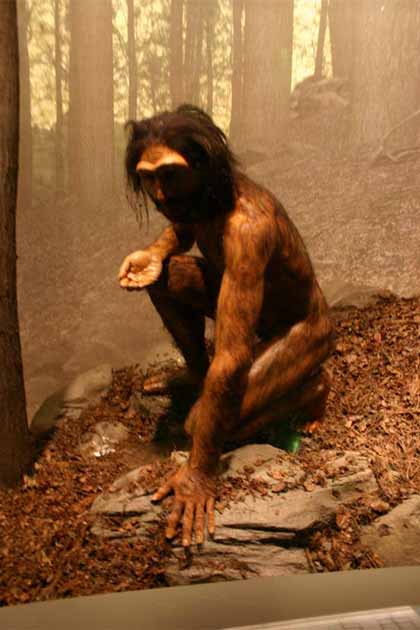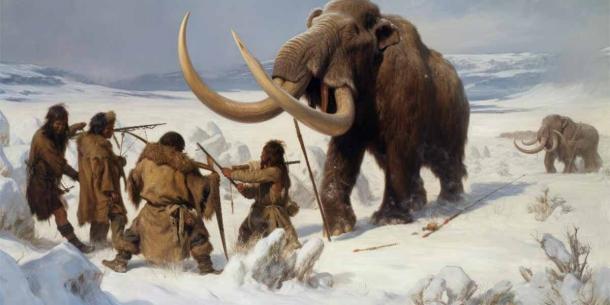
Massive Climate Catastrophe Froze Europe’s Earliest Humans to Death
An interdisciplinary team of archaeologists, anthropologists and earth scientists have found evidence that a severe cooling event in the North Atlantic region approximately 1.1 million years ago wiped out all the archaic humans that populated Europe at that time.
As has just been reported in the journal Science, this massive and sudden freeze in the Early Pleistocene epoch rendered huge sections of Europe virtually uninhabitable for a period of approximately 4,000 years, and it would be another 200,000 years before archaic human hunter-gatherers were once again roaming across the continent.

A late Pleistocene landscape in northern Spain. (Mauricio Antón / CC BY 2.5)
Signs of an Archaic Human Extinction
Based on the study of ancient fossils recovered in Spain, the researchers involved in this new study believe the doomed species was Homo erectus, one of the better-known members of the evolutionary line that eventually produced Homo sapiens.
- Why do Ice Ages occur? A New Paradigm Shift on a Prehistoric Problem
- Scientists Warn That What Killed Past Human Species Could End Us Too

Homo erectus. (Ryan Somma / CC BY-SA 2.0)
It is already known that Homo erectus was the first archaic human species to migrate out of Africa, and also the first to make stone tools like those that were later used by modern humans. Previous fossil finds have shown that Homo erectus had settled in many different parts of Eurasia between 1.8 and 1.2 million years ago. Based on such discoveries, and on the absence of Homo erectus fossils in Europe from later periods, it would seem they disappeared completely following the onset of the Early Pleistocene climate catastrophe.
Up to now it had been assumed that Homo erectus had disappeared gradually from Europe, perhaps because they chose to migrate to the east and south in search of warmer conditions or more abundant resources. Now it seems they never had the chance to leave, but were instead the victim of an unexpected environmental calamity.
A Gap in the Fossil Records Finally Explained
For the purposes of this study, the team of researchers analyzed deep-sea sediment core samples taken off the coast of Portugal that contained organic residues in the form of ancient algae and pollen. The characteristics of these residues suggested unusual temperature and vegetation variations had been experienced in the region 1.1 million years ago, ones that left its mark on all the creatures that occupied continental Europe and its adjacent oceans at that time.
To find out what had happened, the researchers ran computer simulations to determine what the climate must have been like in Europe at that time. They were stunned to discover that average air temperatures would have been about eight degrees Fahrenheit or 4.5 degrees Celsius lower than in previous periods, meaning the climate had taken a dramatically cold turn and that many species of plants and animals wouldn’t have been able to survive.
UCL - Vas - v9 from Newswise on Vimeo.
One of these species, it appears, was Homo erectus. Under intensely frigid conditions that would have persisted for thousands of years, it seems these archaic human hunter-gatherers had no way to cope. Those who had the opportunity to flee to warmer locations may have done so, but those who couldn’t escape would have died out completely.
"There was probably a complete interruption in the early human occupation of Europe, possibly for a considerable time, with an entirely new population eventually coming back," study co-author Chris Stringer, an anthropologist from the Natural History Museum in London, told Reuters.
This would have represented a true apocalypse, although exactly how many ancient humans would have died in the climate calamity is uncertain. But the numbers wouldn’t have seemed particularly large by modern standards. According to Stringer, the total archaic human population in Europe at the time would have likely numbered in the tens of thousands.
A close look at the fossil record confirms that archaic human occupation of Europe was interrupted about 1.1 million years ago. From then until about 900,000 years ago, archaeologists and anthropologists have been unable to find much in the way of human remains or stone tools anywhere on the continent.
Once human ancestors returned, they remained on the continent in one form or another from that point on, which is notable because Ice Age cycles would plunge the lands of Europe into a deep freeze eight more times between 700,000 and 15,000 years ago. Study co-author Chronis Tzedakis, a University College of London physical geography professor, said:
“If this [the 200,000-year gap in the fossil record] is true, then Europe may have been recolonized around 900,000 years ago by more resilient humans with evolutionary or behavioral changes that allowed survival in the increasing intensity of glacial conditions.”

More resilient humans could survive in the increasing intensity of glacial conditions. (Justinas / Adobe Stock)
Humanity Rises Again in Europe
So, who were these later archaic human occupiers of Europe?
Homo antecessor may have been the first, since their fossilized bones have been found in Spain and have been dated back to 850,000 years ago. About 250,000 years after that Homo heidelbergensis, which is believed to be the direct ancestor of modern humans, showed up in Germany. The Neanderthals first arrived in Spain about 430,000 years ago, and continued to come to Europe from Africa for at least another 200,000 years after that. All would have survived periods of maximum glacial advance, doing things like making clothes from animal skins and lighting fires in caves to stay warm, or storing frozen or preserved meat to make sure they had enough to eat all year round.
- The Little Ice Age and Its Giant Impact on Human History
- Holocene Extinction, Anthropocene Extinction, or Merely the Dust in the Wind?

Neanderthals and other prehistoric humans would have relied on the use of animal skins and fires when they went to Europe after the archaic human extinction there. (dasom / Adobe Stock)
Homo sapiens arrived late to the party. A few traveling groups made their way to Europe from Africa around 200,000 years ago and at other points in the next century after that, and then much larger groups began migrating to Europe to settle for good about 60,000 years ago. These early modern humans were in Europe during the last great freeze that accompanied the last glacial maximum period between 26,500 and 15,000 years ago, and like their most immediate archaic human predecessors made it through the extreme cold just fine.
As for the less adaptable Homo erectus, they managed to survive for the next million years after the North Atlantic cooling event in warmer parts of the world, specifically in Asia. The last known Homo erectus colony died out on the island of Java just over 100,000 years ago, bringing an end to an archaic species that had once roamed across all the lands of Eurasia, settling the entire continent more than a million years before modern humans would repeat this achievement.
Top image: A frigid apocalypse 1.1 million years ago led to an archaic human extinction in Europe. Source: Lazy_Bear / Adobe Stock.
By Nathan Falde















